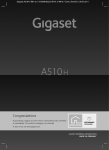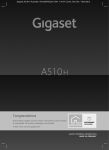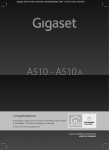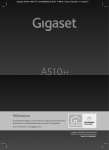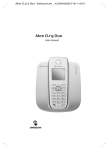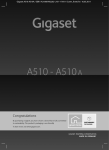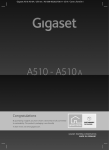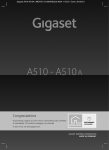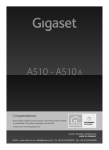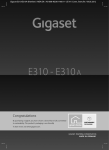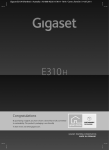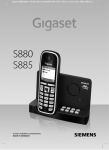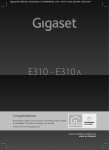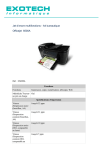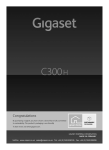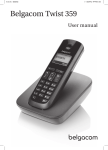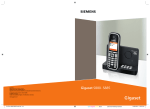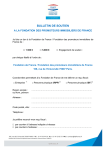Download Congratulations
Transcript
Gigaset E710H / WDCT China EN / A31008-M2252-Y101-1-5D19 / Cover_front.fm /
Congratulations
By purchasing a Gigaset, you have chosen a brand that is fully committed
to sustainability. This product’s packaging is eco-friendly!
To learn more, visit www.gigaset.com.
Gigaset E710H / WDCT China EN / A31008-M2252-Y101-1-5D19 / introduction.fm / 14.09.2012
Gigaset E710H – your high-quality accessory
Gigaset E710H – your high-quality accessory
Congratulations on your purchase of this latest generation Gigaset.
Your Gigaset can do a lot more than just make calls:
Directory for 150 entries
Save phone numbers and names to the directory (¢ page 25). You can designate important
entries as VIPs (Very Important Persons). VIP calls are then recognised by their ringtone and
their background colour (¢ page 26).
If you don't (always) want it to ring
Use time control for calls (¢ page 33) or ensure that all calls from a withheld number are not
signalled (¢ page 33).
Other practical information
Transfer the directory from an existing Gigaset handset (¢ page 26), use the shortcut function (¢ page 26) and adjust the background colour and contrast of the display to your
requirements (¢ page 32).
Environment
Gigaset Green Home – be environmentally aware when using your phone. For details of our
ECO WDCT products, visit www.gigaset.com/service.
For more information about your phone, visit www.gigaset.com/gigasetE710h.
After purchasing your Gigaset phone, please register it at www.gigaset.com/service – this
will ensure any questions you may have or warranty services you request are dealt with even
faster!
Version 4.1, 21.11.2007
Have fun using your new phone!
1
Gigaset E710H / WDCT China EN / A31008-M2252-Y101-1-5D19 / overview.fm / 14.09.2012
Overview
Overview
1
Ð
U
14
INT 1
12.04.
10:53
Redial
Menu
13
12
2
3
11
4
10
5
6
Version 4.1, 21.11.2007
7
2
9
8
1 Signal strength (¢ page 15)
2 Control key (¢ page 17)
Mute microphone (¢ page 24)
3 Talk/Handsfree key
Flashing: incoming call;
Lights up: handsfree mode activated; accept
call; open redial list (press briefly);
start dialling (press and hold);
During a call: switch between earpiece and
handsfree mode (¢ page 23)
4 Key 1
Open the answering machine (dependent on
base)/network mailbox (press and hold)
5 Star key
Activate/deactivate ringtones
(press and hold);
With an open connection: switch from pulse
dialling to tone dialling (press briefly)
6 Message key (¢ page 28)
Access to calls and message lists;
Flashing: new message or new call
7 Microphone
8 Recall key
- Consultation call (flash)
- Insert a dialling pause (press and hold)
9 Hash key
Keypad lock on/off (press and hold in idle status);
Toggles between upper/lower case and digits
10 IP key (¢ page 26)
11 End call key, On/Off key
End call; cancel function; go back one menu
level (press briefly); back to idle status
(press and hold); activate/deactivate handset
(press and hold in idle status)
12 Display keys (¢ page 4)
13 Display in idle status
14 Charge status of the batteries (¢ page 15)
Please note
To change the display language, proceed as
described on page 12/page 32.
Gigaset E710H / WDCT China EN / A31008-M2252-Y101-1-5D19 / overview.fm / 14.09.2012
Display icons
Display icons
The following icons are displayed depending on the settings and the operating status of your
telephone:
Signal strength ¨ (¢ page 15)
Keypad locked (¢ page 19)
Ringtone switched off (¢ page 34)
Batteries are charged (¢ page 15)
Charge status of the batteries (¢ page 15)
Ð
Ø ó
U
INT 1
12.04.
Name of the handset
10:53
Current day/current time (¢ page 14)
INT 1
ë12:00
10:53
Ã
™
03
01
Alarm clock switched on and wake up time set (¢ page 31)
Number of new messages:
u à On the answering machine (dependent on base)/network mailbox (¢ page 28)
u ™ In the missed calls list (¢ page 28)
Redial U Menu
Display keys (¢ page 4)
Display during external call:
—
1234567890
Number (or name) of caller
00:00:53
Call duration
Menu
Version 4.1, 21.11.2007
Connection established
Display key (¢ page 4)
u Set call volume (¢ page 32)
u Access service information
3
Gigaset E710H / WDCT China EN / A31008-M2252-Y101-1-5D19 / overview.fm / 14.09.2012
Display keys
Other display icons:
Establishing a connection
z
Connection established
External call (¢ page 23)
Internal call (¢ page 24)
Alarm call (¢ page 31)
Please wait...
Information
Query
Û
À
Display keys
Main menu icons
The functions of the display keys change
depending on the particular operating situation. Examples:
Redial
¶
Action failed
μ
1
Ø ì Ú
Ø å Ú
Ð
Action complete
Menu
2
1
2
1 Current display key function
2 Display keys
Version 4.1, 21.11.2007
˜
—
Ø Ü Ú
Important display keys:
Redial
Open redial list.
Menu
Open a menu for further functions.
OK
Confirm selection.
Del.
Delete key: delete one character
at a time from right to left.
Back
Go back one menu level or cancel operation.
4
Connection cannot be
established or connection
interrupted
ì
Alarm Clock
Back V
OK
ì Alarm Clock
Ì Voice Mail
Ï Settings
Information on using the menus
(¢ page 18)
Menu overview (¢ page 22)
Gigaset E710H / WDCT China EN / A31008-M2252-Y101-1-5D19 / E710HIVZ.fm / 14.09.2012
Contents
Contents
Gigaset E710H – your high-quality accessory . . . . . . . . . . . . . . . . . . . . . . . . 1
Overview . . . . . . . . . . . . . . . . . . . . . . . . . . . . . . . . . . . . . . . . . . . . . . . . . . . . . . . . . 2
Display icons . . . . . . . . . . . . . . . . . . . . . . . . . . . . . . . . . . . . . . . . . . . . . . . . . . . . . . 3
Display keys . . . . . . . . . . . . . . . . . . . . . . . . . . . . . . . . . . . . . . . . . . . . . . . . . . . . . . . 4
Main menu icons . . . . . . . . . . . . . . . . . . . . . . . . . . . . . . . . . . . . . . . . . . . . . . . . . . 4
Safety precautions . . . . . . . . . . . . . . . . . . . . . . . . . . . . . . . . . . . . . . . . . . . . . . . . . 7
First steps . . . . . . . . . . . . . . . . . . . . . . . . . . . . . . . . . . . . . . . . . . . . . . . . . . . . . . . . . 8
Checking the package contents . . . . . . . . . . . . . . . . . . . . . . . . . . . . . . . . . . . . . . . . . . . . . . . 8
Setting up the charger . . . . . . . . . . . . . . . . . . . . . . . . . . . . . . . . . . . . . . . . . . . . . . . . . . . . . . . . 9
Connecting the charger . . . . . . . . . . . . . . . . . . . . . . . . . . . . . . . . . . . . . . . . . . . . . . . . . . . . . . . 9
Setting up the handset for use . . . . . . . . . . . . . . . . . . . . . . . . . . . . . . . . . . . . . . . . . . . . . . . 10
Changing the display language . . . . . . . . . . . . . . . . . . . . . . . . . . . . . . . . . . . . . . . . . . . . . . 12
Registering the handset . . . . . . . . . . . . . . . . . . . . . . . . . . . . . . . . . . . . . . . . . . . . . . . . . . . . . . 13
Setting the date/time . . . . . . . . . . . . . . . . . . . . . . . . . . . . . . . . . . . . . . . . . . . . . . . . . . . . . . . . 14
What would you like to do next? . . . . . . . . . . . . . . . . . . . . . . . . . . . . . . . . . . . . . . . . . . . . . . 16
Using the phone . . . . . . . . . . . . . . . . . . . . . . . . . . . . . . . . . . . . . . . . . . . . . . . . . . 17
Control key . . . . . . . . . . . . . . . . . . . . . . . . . . . . . . . . . . . . . . . . . . . . . . . . . . . . . . . . . . . . . . . . . .
Keys on the keypad . . . . . . . . . . . . . . . . . . . . . . . . . . . . . . . . . . . . . . . . . . . . . . . . . . . . . . . . . .
Correcting incorrect entries . . . . . . . . . . . . . . . . . . . . . . . . . . . . . . . . . . . . . . . . . . . . . . . . . .
Using the menu . . . . . . . . . . . . . . . . . . . . . . . . . . . . . . . . . . . . . . . . . . . . . . . . . . . . . . . . . . . . . .
Activating/deactivating the handset . . . . . . . . . . . . . . . . . . . . . . . . . . . . . . . . . . . . . . . . . .
Activating/deactivating the keypad lock . . . . . . . . . . . . . . . . . . . . . . . . . . . . . . . . . . . . . .
Understanding the operating steps . . . . . . . . . . . . . . . . . . . . . . . . . . . . . . . . . . . . . . . . . . .
17
17
17
18
19
19
20
Menu tree . . . . . . . . . . . . . . . . . . . . . . . . . . . . . . . . . . . . . . . . . . . . . . . . . . . . . . . . 22
Making calls . . . . . . . . . . . . . . . . . . . . . . . . . . . . . . . . . . . . . . . . . . . . . . . . . . . . . . 23
Making an external call . . . . . . . . . . . . . . . . . . . . . . . . . . . . . . . . . . . . . . . . . . . . . . . . . . . . . .
Ending a call . . . . . . . . . . . . . . . . . . . . . . . . . . . . . . . . . . . . . . . . . . . . . . . . . . . . . . . . . . . . . . . . .
Accepting a call . . . . . . . . . . . . . . . . . . . . . . . . . . . . . . . . . . . . . . . . . . . . . . . . . . . . . . . . . . . . . .
Handsfree mode . . . . . . . . . . . . . . . . . . . . . . . . . . . . . . . . . . . . . . . . . . . . . . . . . . . . . . . . . . . . .
Switching to mute . . . . . . . . . . . . . . . . . . . . . . . . . . . . . . . . . . . . . . . . . . . . . . . . . . . . . . . . . . .
Making internal calls . . . . . . . . . . . . . . . . . . . . . . . . . . . . . . . . . . . . . . . . . . . . . . . . . . . . . . . . .
23
23
23
23
24
24
Version 4.1, 21.11.2007
Using the directory and lists . . . . . . . . . . . . . . . . . . . . . . . . . . . . . . . . . . . . . . . 25
Directory . . . . . . . . . . . . . . . . . . . . . . . . . . . . . . . . . . . . . . . . . . . . . . . . . . . . . . . . . . . . . . . . . . . .
Redial list . . . . . . . . . . . . . . . . . . . . . . . . . . . . . . . . . . . . . . . . . . . . . . . . . . . . . . . . . . . . . . . . . . . .
Function of the message key . . . . . . . . . . . . . . . . . . . . . . . . . . . . . . . . . . . . . . . . . . . . . . . . .
Answering machine list (dependent on base) . . . . . . . . . . . . . . . . . . . . . . . . . . . . . . . . .
Calls list (dependent on base) . . . . . . . . . . . . . . . . . . . . . . . . . . . . . . . . . . . . . . . . . . . . . . . .
25
27
28
29
29
5
Gigaset E710H / WDCT China EN / A31008-M2252-Y101-1-5D19 / E710HIVZ.fm / 14.09.2012
Contents
Using the network mailbox . . . . . . . . . . . . . . . . . . . . . . . . . . . . . . . . . . . . . . . 30
Using fast access for the network mailbox . . . . . . . . . . . . . . . . . . . . . . . . . . . . . . . . . . . . 30
Viewing the network mailbox message . . . . . . . . . . . . . . . . . . . . . . . . . . . . . . . . . . . . . . . 30
ECO WDCT . . . . . . . . . . . . . . . . . . . . . . . . . . . . . . . . . . . . . . . . . . . . . . . . . . . . . . . 31
Using the handset as an alarm clock . . . . . . . . . . . . . . . . . . . . . . . . . . . . . . . 31
Setting the handset . . . . . . . . . . . . . . . . . . . . . . . . . . . . . . . . . . . . . . . . . . . . . . 32
Changing the display language . . . . . . . . . . . . . . . . . . . . . . . . . . . . . . . . . . . . . . . . . . . . . .
Setting the display/screensaver . . . . . . . . . . . . . . . . . . . . . . . . . . . . . . . . . . . . . . . . . . . . . .
Automatically activating/deactivating auto answer . . . . . . . . . . . . . . . . . . . . . . . . . . .
Changing the handsfree/earpiece volume . . . . . . . . . . . . . . . . . . . . . . . . . . . . . . . . . . . .
Changing ringtones . . . . . . . . . . . . . . . . . . . . . . . . . . . . . . . . . . . . . . . . . . . . . . . . . . . . . . . . . .
Restoring the handset default settings . . . . . . . . . . . . . . . . . . . . . . . . . . . . . . . . . . . . . . . .
32
32
32
32
33
34
Customer Care and Support . . . . . . . . . . . . . . . . . . . . . . . . . . . . . . . . . . . . . . . 35
Questions and answers . . . . . . . . . . . . . . . . . . . . . . . . . . . . . . . . . . . . . . . . . . . . . . . . . . . . . . 35
Environment . . . . . . . . . . . . . . . . . . . . . . . . . . . . . . . . . . . . . . . . . . . . . . . . . . . . . 35
Appendix . . . . . . . . . . . . . . . . . . . . . . . . . . . . . . . . . . . . . . . . . . . . . . . . . . . . . . . . 36
Caring for your telephone . . . . . . . . . . . . . . . . . . . . . . . . . . . . . . . . . . . . . . . . . . . . . . . . . . . .
Contact with liquid . . . . . . . . . . . . . . . . . . . . . . . . . . . . . . . . . . . . . . . . . . . . . . . . . . . . . . . . . .
Specifications . . . . . . . . . . . . . . . . . . . . . . . . . . . . . . . . . . . . . . . . . . . . . . . . . . . . . . . . . . . . . . . .
Writing and editing text . . . . . . . . . . . . . . . . . . . . . . . . . . . . . . . . . . . . . . . . . . . . . . . . . . . . . .
36
36
36
37
Accessories . . . . . . . . . . . . . . . . . . . . . . . . . . . . . . . . . . . . . . . . . . . . . . . . . . . . . . . 39
Mounting the charger on the wall . . . . . . . . . . . . . . . . . . . . . . . . . . . . . . . . . 39
Version 4.1, 21.11.2007
Index . . . . . . . . . . . . . . . . . . . . . . . . . . . . . . . . . . . . . . . . . . . . . . . . . . . . . . . . . . . . 40
6
Gigaset E710H / WDCT China EN / A31008-M2252-Y101-1-5D19 / security.fm / 14.09.2012
Safety precautions
Safety precautions
Warning
Read the safety precautions and the user manual before use.
Explain their content and the potential hazards associated with using the telephone to your
children.
$
Use only the power adapter supplied, as indicated on the underside of the base.
Use only rechargeable batteries that correspond to the specification provided on
page 36, as this could otherwise result in significant health risks and personal injury.
Using your telephone may affect nearby medical equipment. Be aware of the technical conditions in your particular environment, e.g., doctor's surgery.
If you use a medical device (e.g., a pacemaker), please contact the device manufacturer. They will be able to advise you regarding the susceptibility of the device to
external sources of high frequency energy. Please refer to the "Appendix" chapter
for the specifications of this Gigaset product.
Do not hold the rear of the handset to your ear when it is ringing or when handsfree
mode is activated. Otherwise you risk serious and permanent damage to your hearing.
Your Gigaset is compatible with the majority of digital hearing aids on the market.
However, perfect function with all hearing aids cannot be guaranteed.
The handset may cause interference in analogue hearing aids. If you require assistance, please contact the hearing aid supplier.
Do not install the charger in bathrooms or shower rooms. The charger is not splashproof (¢ page 36).
Do not use your phone in environments with a potential explosion hazard (e.g.,
paint shops).
ƒ
If you give your phone to a third party, make sure you also give them the user
manual.
Remove faulty bases from use or have them repaired by our Service team, as these
could interfere with other wireless services.
Please note
Version 4.1, 21.11.2007
u Not all of the functions described in this user guide are available in all countries.
u The device cannot be used in the event of a power failure. It is also not possible to transmit emergency calls.
7
Gigaset E710H / WDCT China EN / A31008-M2252-Y101-1-5D19 / starting.fm / 14.09.2012
First steps
First steps
Checking the package contents
1
2
4
3
6
Version 4.1, 21.11.2007
1 One Gigaset E710H handset
2 Two batteries
3 One battery cover
4 One charger
5 One power adapter
6 One user guide
8
3
5
Gigaset E710H / WDCT China EN / A31008-M2252-Y101-1-5D19 / starting.fm / 14.09.2012
First steps
Setting up the charger
The charger is designed for use in dry rooms in a temperature range of +5°C
to +45°C.
¤ Set up the charger on a level, non-slip surface or mount the charger on the wall
(¢ page 39).
Please note
Pay attention to the range of the base.
This is up to 300 m in unobstructed outdoor areas and up to 50 m inside buildings. The range is reduced when Eco Mode is activated (¢ page 31).
The phone's feet do not usually leave any marks on surfaces. However, due to the
multitude of different varnishes and polishes used on today's furnishings, the
occurrence of marks on the surfaces cannot be completely ruled out.
Please note:
u Never expose the telephone to the effects of heat sources, direct sunlight or
other electrical devices.
u Protect your Gigaset from moisture, dust, corrosive liquids and fumes.
Connecting the charger
2
1
¤ Connect the flat plug from the
power adapter 1.
¤ Plug the power adapter into the
plug socket 2.
4
Version 4.1, 21.11.2007
Should you wish to disconnect the plug from the
charger again, press the release button 3 and
disconnect the plug 4.
3
9
Gigaset E710H / WDCT China EN / A31008-M2252-Y101-1-5D19 / starting.fm / 14.09.2012
First steps
Setting up the handset for use
The display is protected by a plastic film.
Please remove the protective film!
Inserting the battery and closing the battery cover
¤ Insert the batteries with
the polarity in the
correct direction.
The polarity is indicated
in the battery compartment.
a
b
Version 4.1, 21.11.2007
To open the battery cover, for
instance to replace the batteries,
insert a coin into the cavity on the
casing, then pull the battery cover
in an upward direction.
10
¤ First insert the battery
cover at the top a.
¤ Then press the cover b
until it clicks into place.
Gigaset E710H / WDCT China EN / A31008-M2252-Y101-1-5D19 / starting.fm / 14.09.2012
First steps
Initial charging and discharging of the batteries
The correct charge status can only be displayed if the batteries are first fully
charged and discharged.
¤ Charge the handset in the charger for 5.5 hours.
5.5 h
Please note
The handset may only be placed in the designated base/charger.
¤ After charging, remove the handset from the charger and only replace it when
the batteries are fully discharged.
Please note
u After the first battery charge and discharge, you may place your handset in
the charger after every call.
u Always repeat the charging and discharging procedure if you remove the
batteries from the handset and reinsert them.
u The batteries may warm up during charging. This is not dangerous.
u After a while, the charge capacity of the batteries will decrease for technical
reasons.
Version 4.1, 21.11.2007
If you have any questions about using your phone, please read the tips
on troubleshooting (¢ page 35) or contact our Customer Care team
(¢ page 35).
11
Gigaset E710H / WDCT China EN / A31008-M2252-Y101-1-5D19 / starting.fm / 14.09.2012
First steps
Changing the display language
Change the display language if you do not understand the language currently set.
¤ Press right on the control key.
L 4
English
³
¤ Press the keys L and 4 slowly one
after the other.
The display for setting languages appears
and the current language (e.g., English) is
selected
¤ Press down on the control key s ...
Francais
Back U
´
... until the language you wish to use is
displayed e.g., French.
OK
¤ Press the key below §OK§ to select this
language.
Francais
English
x
³³
The selection is marked with ³.
Version 4.1, 21.11.2007
¤ Press and hold the end call key a to return to idle status.
12
Gigaset E710H / WDCT China EN / A31008-M2252-Y101-1-5D19 / starting.fm / 14.09.2012
First steps
Registering the handset
Before you can use the phone, you must first register the handset to the base.
The registration procedure will depend on the type of base.
Automatically registering the E710H handset to the Gigaset E710/
E710A base
Prerequisite: The handset must not already be registered to a base.
¥
U
Place handset
¤ Place the handset with the display
facing up in the base.
into base
Time
Redial
ì
Handset is
registering
The handset registers automatically.
Registration can take up to 5 minutes.
Do not remove the handset from the
base during this time.
Please note
u Each key press interrupts automatic registration.
u If the handset is already registered to a base or if automatic registration does
not work, the handset will have to be registered manually.
Manually registering the E710H handset
You must manually register the handset on both the handset (1) and the base (2).
1) On the handset
§Menu§ ¤ Settings ¤ Registration ¤ Register Handset
~
If required, enter the system PIN for the base (the default is 0000).
Press the display key.
The display shows Handset is registering.
§OK§
Version 4.1, 21.11.2007
2) On the base
¤ Within 60 seconds, press and hold the registration/paging key on the base
(approx. 3 seconds).
13
Gigaset E710H / WDCT China EN / A31008-M2252-Y101-1-5D19 / starting.fm / 14.09.2012
First steps
Once registration is complete, the handset returns to idle status. The handset's
internal number is shown in the display e.g., INT 2. If not, repeat the procedure.
Please note
For instructions on de-registering the handsets, please consult the base user
guide.
Setting the date/time
Set the date and time so that the correct date and time can be assigned to incoming calls, and so that the alarm can be used.
Please note
Depending on your network provider, the date and time may be displayed
automatically.
Redial
Time
¤ Press the key below §Time§ on the display
screen to open the input field.
(If you have already set the date/time,
open the input field via the menu
¢ page 22.)
The Date/Time submenu is shown on the
display.
¤ The active input position flashes.
Enter the year, month and day as an
8-digit number via the keypad
e.g., 2Q12Q421
for 21 April 2012.
Enter Date:
[2012.04.21]
To change the input position e.g.,
to correct an entry, press right or
left on the control key.
Version 4.1, 21.11.2007
Back
14
OK
¤ Press the key below §OK§ on the display
screen to save your entry.
Gigaset E710H / WDCT China EN / A31008-M2252-Y101-1-5D19 / starting.fm / 14.09.2012
First steps
Enter Time:
¤ Enter the hours and minutes in 4-digit
format via the keypad e.g., QM15
for 07:15 am.
Change the input position with the
control key if necessary.
[07:15]
Back
OK
¤ Confirm with §OK§.
μ
Saved
The display shows Saved. You will hear a
confirmation tone and the handset automatically reverts to idle status, or returns
to the "Settings" menu if the setting was
made via the menu.
Display in idle status
Once the phone is registered and the time set, the screen display appears as follows
(example).
U
Ð
u Reception between the base and the handset:
– Good to poor: Ð ¨ § ¦
INT 1
– No reception: ¥
u Charge status of the batteries:
12.04.
10:53
– U Charged over 66%
Redial
Menu
– V Charged between 34% and 66%
– e Charged between 11% and 33%
– = Charged below 11%
– = Flashes: battery almost empty (less than 10 minutes talktime)
– = e V V Illuminated: batteries charging
u INT 1
Internal name of the handset
Version 4.1, 21.11.2007
Screen display
Your phone is now ready for use.
15
Gigaset E710H / WDCT China EN / A31008-M2252-Y101-1-5D19 / starting.fm / 14.09.2012
First steps
What would you like to do next?
Now that you have successfully set up your Gigaset, you can immediately start calling – or you can adapt it to your personal requirements. Use the following guide to
quickly locate the most important functions.
Information on ...
Using the phone
Setting ringtones
Transferring directory entries from existing Gigaset
handsets to new handset(s)
Setting Eco Mode
Version 4.1, 21.11.2007
Setting the earpiece volume
16
... is located here.
g
g
g
g
g
page 17
page 33
page 26
page 31
page 32
Gigaset E710H / WDCT China EN / A31008-M2252-Y101-1-5D19 / starting.fm / 14.09.2012
Using the phone
Using the phone
Control key
In the description below, the side of the control key (up, down,
right, left) that you have to press in the different operating situations is marked in black e.g., v for "press the right edge of the
control key".
The control key has a number of different functions:
When the handset is in idle status
v
s
u
t
Open the main menu.
Open the directory.
Open the list of handsets.
Call up the menu for setting the handset's call volume (¢ page 32).
In menus and lists
t/s
Scroll up/down line by line.
In input fields
You can use the control key to move the cursor up t, down s, right v or left u.
During an external call
v
s
u
t
Mute the microphone.
Open the directory.
Initiate an internal consultation call.
Adjust the loudspeaker volume for earpiece and handsfree mode.
Keys on the keypad
c/Q/P etc.
Press the corresponding key on the handset.
~
Enter digits or letters.
Correcting incorrect entries
Version 4.1, 21.11.2007
You can correct incorrect characters in the input fields by navigating to the incorrect entry using the control key. You can then:
u Use the display key §Del.§ to delete the character to the left of the cursor
u Insert characters at the cursor position
u Overwrite the highlighted (flashing) character e.g., when entering time and
date.
17
Gigaset E710H / WDCT China EN / A31008-M2252-Y101-1-5D19 / starting.fm / 14.09.2012
Using the phone
Using the menu
Your telephone's functions are accessed via a menu consisting of several levels
(menu overview ¢ page 22).
Main menu (first menu level)
¤ With the handset in idle status, press the display key §Menu§ or right on the control key v to open the main menu.
The functions in the main menu are displayed in the
form of a list with names and icons (example on the
right).
Ï
Selecting a function
Settings
¤ You can scroll between functions using the control
key q. The selectable function is shown in the
display.
Back W
OK
¤ Press the display key §OK§ or right on the control
key v to select the displayed function. This opens
the corresponding submenu and the first entry is
displayed.
If you press the display key §Back§, left on the control key u or briefly press the end
call key a, the display returns to idle status.
Submenus
The functions in the submenu are displayed with the corresponding names.
Selecting a function
¤ You can scroll between functions using the control key q. The relevant function
is shown in the display.
¤ Press the display key §OK§ to activate/deactivate the function or to open another
submenu.
If you press the display key §Back§, left on the control key u or briefly press the end
call key a, you return to the previous menu level or cancel the operation.
Any settings you have not confirmed by pressing §OK§ will be discarded.
Reverting to idle status
Version 4.1, 21.11.2007
From any point in the menu:
¤ Press and hold the end call key a or
¤ Do not press any key: after 2 minutes, the display will automatically revert to
idle status.
An example of the display in idle status is shown on page 15.
18
Gigaset E710H / WDCT China EN / A31008-M2252-Y101-1-5D19 / starting.fm / 14.09.2012
Using the phone
Activating/deactivating the handset
a
In idle status, press and hold the end call key (confirmation tone).
Activating/deactivating the keypad lock
The keypad lock prevents any inadvertent use of the phone.
#
In idle status, press and hold the hash key (confirmation tone). The keypad lock is activated or deactivated. When the keypad lock is activated,
the Ø icon appears in the display.
If the keypad lock is activated, a corresponding message is displayed when you
press a key.
The keypad lock deactivates automatically when you receive a call. It is reactivated
when the call is finished.
Please note
Version 4.1, 21.11.2007
When the keypad lock is active, you cannot call emergency numbers.
19
Gigaset E710H / WDCT China EN / A31008-M2252-Y101-1-5D19 / starting.fm / 14.09.2012
Using the phone
Understanding the operating steps
The operating steps are shown in abbreviated form, for example:
§Menu§ ¤ Settings ¤ Eco Mode (³ = on)
¤ This means you should proceed as follows:
Menu
Redial
¤ Press the key below §Menu§ on the display screen to open the main menu.
¤ Press down on the control key s ...
Ï
Settings
Back W
... until the Settings menu item
appears.
OK
¤ Press the key below §OK§ on the display
screen to confirm your selection.
Version 4.1, 21.11.2007
¤ Press down on the control key s ...
20
Gigaset E710H / WDCT China EN / A31008-M2252-Y101-1-5D19 / starting.fm / 14.09.2012
Using the phone
Eco Mode
Back W
³
OK
... until the Eco Mode+ menu item
appears.
¤ Press the key below §OK§ on the display
screen to switch the function on or off
(³ = on).
Version 4.1, 21.11.2007
¤ Press the key below §Back§ on the display screen to jump back to the previous
menu level.
Or
Press and hold the end call key a to return to idle status.
21
Gigaset E710H / WDCT China EN / A31008-M2252-Y101-1-5D19 / menuetree.fm / 14.09.2012
Menu tree
Menu tree
The menu entries are divided into sections. The page numbers refer to the
relevant description in the user guide.
To open the main menu: press the §Menu§ display key when the phone is in idle mode.
ì Alarm Clock
Activation
¢ page 31
Wake up time
¢ page 31
Ì Voice Mail
Ï Settings
Date/Time
Audio Settings
Display
Language
Registration
Telephony
(Menu dependent on base)
¢ page 14
Call Volume
¢ page 32
Ringer Volume
¢ page 33
Advisory Tones
¢ page 34
Battery Low
¢ page 34
Ringtones (Handset)
¢ page 33
Ringtones (Base)
(dependent on base)
Screensaver
¢ page 32
Colour Schemes
¢ page 32
Contrast
¢ page 32
¢ page 32
Register Handset
¢ page 13
De-register Handset
(dependent on base)
Auto Answer
¢ page 32
(further submenus dependent on base)
System
Reset Handset
¢ page 34
(further submenus dependent on base)
Version 4.1, 21.11.2007
Eco Mode
22
¢ page 31
Gigaset E710H / WDCT China EN / A31008-M2252-Y101-1-5D19 / telefony.fm / 14.09.2012
Making calls
Making calls
Making an external call
External calls are calls using the public
telephone network.
~c
Enter the number and press the
talk key.
Or:
c ~
Press and hold the talk key c
and then enter the number.
You can cancel the dialling process with the
end call key a.
You are shown the duration of the call while
the call is in progress.
Please note
Dialling with the directory (¢ page 25),
calls list (¢ page 29) and redial list
(¢ page 27) saves you from repeatedly
keying in phone numbers.
Ending a call
a
Press the end call key.
Accepting a call
Handsfree mode
In handsfree mode, you activate the loudspeaker so that you can hear the caller without having to hold the handset to your ear.
You therefore have both hands free and
other people can listen in on the conversation.
Please note
Inform your caller before you use the
handsfree function so that the caller
knows a third party may be listening.
Activating/deactivating handsfree
mode
During a call, activate or deactivate handsfree mode:
d
Press the handsfree key.
Each key press switches
between earpiece and handsfree mode. If handsfree mode is
activated, the key is lit up.
If you wish to place the handset in the
charger during a call:
¤ Press and hold the handsfree key d
while placing the handset in the base/
charger and for a further 2 seconds.
For instructions on adjusting the handsfree
volume, see page 32.
Version 4.1, 21.11.2007
The handset indicates an incoming call in
three ways: by ringing, by a display on the
screen and by the flashing talk key c.
To accept the call, press the talk key c.
If the handset is in the charger and the Auto
Answer function is activated (¢ page 32),
the handset automatically answers calls
when you remove it from the base/charger.
If the ringer is intrusive, you can deactivate
it:
§Menu§ ¤ Silent ¤ §OK§
You can accept the call as long as it is displayed on the screen.
23
Gigaset E710H / WDCT China EN / A31008-M2252-Y101-1-5D19 / telefony.fm / 14.09.2012
Making calls
Switching to mute
You can deactivate your handset's microphone during a call.
v
Press right on the control key
to mute the handset.
The display shows Microphone
is switched off.
Press the key again to unmute
the microphone.
Making internal calls
Internal calls are free calls between handsets
that are registered with the same base.
Calling a specific handset
u
~
Or:
u
s
c
Initiate internal call.
Enter the number of the handset.
Initiate internal call.
Select handset.
Press the talk key.
Calling all handsets ("group call")
u
Press and hold.
Or:
u
Initiate internal call.
P
Press the star key.
Or:
u
Initiate internal call.
Call All
Select
c
Press the talk key.
All handsets are called.
Ending a call
Version 4.1, 21.11.2007
a
24
Press the end call key.
Gigaset E710H / WDCT China EN / A31008-M2252-Y101-1-5D19 / direct_charges.fm / 14.09.2012
Using the directory and lists
Using the directory and
lists
The options are:
u Directory
u Redial list
u Calls lists
u Answering machine list (dependent on
base)/network mailbox list
You can create a personalised directory for
your own individual handset. You can also
send lists/entries to other handsets
(¢ page 26).
Directory
You can save a total of 150 entries in the
directory.
Please note
To quickly access a number from the
directory (shortcut), you can assign the
number to a key (¢ Using shortcut keys,
page 26).
In the directory, you can save
u Numbers and corresponding names
u VIP ringtones and colours.
You open the directory in idle status using
the s key.
Length of the entries
Number:
Name:
max. 32 digits
max. 16 characters
Storing a number in the directory
s ¤ §Menu§ ¤ New Entry
~
Enter the number and press §OK§.
~
Enter the name and press §OK§.
Order of directory entries
Directory entries are generally sorted alphabetically by surname. Spaces and digits take
first priority.
The sort order is as follows:
1. Space
2. Digits (0–9)
3. Letters (alphabetical)
4. Other characters
To work round the alphabetical order of
entries, insert a space or a digit before the
first letter of the name. These entries will
then move to the beginning of the directory.
Selecting directory entries
s
Open the directory.
You have the following options:
u Use s to scroll through the entries until
the required name is selected.
u Enter the first character of the name, if
necessary scroll to the entry with the s
key.
Dialling with the directory
s ¤ s (Select entry)
c
Press the talk key.
Saving the first number in the
directory
Version 4.1, 21.11.2007
s ¤ Dir. empty New Entry?
~
Enter the number and press §OK§.
~
Enter the name and press §OK§.
25
Gigaset E710H / WDCT China EN / A31008-M2252-Y101-1-5D19 / direct_charges.fm / 14.09.2012
Using the directory and lists
Managing directory entries
Version 4.1, 21.11.2007
s ¤ s (Select entry)
§Menu§
Press the display key.
The following functions can be selected
with q:
VIP Caller Melody
Mark a directory entry as a VIP (Very
Important Person) by assigning a specific
ringtone to it. The entry is flagged with
the Æ icon in the directory. You recognise VIP calls by the ringtone.
VIP Caller Colour
Mark a directory entry as a VIP (Very
Important Person) by assigning a specific
background colour to it. The entry is displayed with this background colour in
the address book and marked with the Æ
icon. VIP calls are then recognised by
their background colour.
Edit Entry
Edit the number if required and press §OK§.
Edit the name if required and press §OK§.
Use Number
Edit or add to a saved number and then
use c to dial the number or save the
number as a new entry;
To do so, display the number and press:
§Menu§ ¤ Copy to Directory ¤ §OK§
Delete Entry
Delete selected entry.
Send Entry
Send a single entry to a handset
(¢ Transferring the directory to another
handset, page 26).
Delete List
Delete all directory entries.
Send List
Send the entire directory to a handset
(¢ Transferring the directory to another
handset, page 26).
Shortcut
Assign the current entry to the IP key or a
shortcut key (¢ next sections "Using the
IP key" and "Using shortcut keys").
26
Using the IP key
You can assign an IP number from the directory to the digit key Q:
s ¤ q (select entry) ¤ §Menu§ ¤ Shortcut
¤ press the key Q
In idle status, press and hold the digit key
Q to start dial preparation with the stored
number.
When the dial preparation screen is active
with some dial numbers, press and hold the
digit key Q to insert the stored number at
the beginning of the already typed numbers.
Using shortcut keys
You can assign directory entries to the keys
2– O:
s ¤ q (select entry) ¤ §Menu§ ¤ Shortcut
¤ ~ (press the key you want to assign the
number to)
In idle status, press and hold the required
shortcut key to dial.
When the dial preparation screen is active
with some dial numbers, press and hold the
required shortcut key to insert the stored
number at the current cursor position.
Transferring the directory to
another handset
You can transfer directory entries from other
handsets to your new handset — even
entries from old handsets.
Prerequisites:
u The sending and receiving handsets
must both be registered to the same
base.
u The other handset and the base can send
and receive directory entries.
s ¤ s (Select entry) ¤ §Menu§ (Open menu)
¤ Send Entry / Send List
s
Select the internal number of
the receiving handset and
press §OK§.
Gigaset E710H / WDCT China EN / A31008-M2252-Y101-1-5D19 / direct_charges.fm / 14.09.2012
Using the directory and lists
You can transfer several individual entries
one after the other by responding to the
Entry copied. Next entry? prompt with §OK§.
A message appears on the display to confirm
a successful transfer. You will hear the confirmation tone.
Please note:
u Entries with identical numbers are not
overwritten on the receiving handset.
u The transfer is cancelled if the phone
rings or if the memory of the receiving
handset is full.
u VIP melodies and colours assigned to
entries are not transferred.
Adding a displayed number to
the directory
You can copy numbers displayed in a list,
e.g., the calls list or redial list, to the directory.
A number is displayed:
§Menu§ ¤ Copy to Directory
¤ Complete the entry (¢ Storing a number
in the directory, page 25).
Manual redial
c
§Redial§
s
c
Press the talk key briefly
Or
Press the display key.
Select entry.
Press the talk key. The number is
dialled.
Managing entries in the redial list
c
Press the talk key briefly
Or
§Redial§
Press the display key.
s
Select entry.
§Menu§
Open menu.
The following functions can be selected
with q:
Use Number
(As in the directory, ¢ page 26)
Copy to Directory (¢ Storing a number in
the directory, page 25)
Delete Entry
Delete selected entry.
Delete List
Delete all entries in the redial list.
Copying a number from the
directory
In some operating situations, you can open
the directory to copy a number (e.g., during
an external call or in pre-dialling mode).
Your handset need not be in idle status.
s
Open the directory.
q
Select an entry and press §OK§.
Redial list
Version 4.1, 21.11.2007
The redial list contains the ten numbers last
dialled with the handset (max. 32 numbers).
If one of the numbers is in the directory, the
corresponding name will be displayed.
27
Gigaset E710H / WDCT China EN / A31008-M2252-Y101-1-5D19 / direct_charges.fm / 14.09.2012
Using the directory and lists
Function of the message key
The list is displayed with the number of new
entries (example):
Opening lists
Use the message key f to open the following lists:
u Answering machine list (dependent on
base) or network mailbox, if your network
provider supports this function and fast
access is set for the network mailbox
(¢ page 30).
u Calls list
An advisory tone sounds as soon as a new
entry arrives in a list.
Depending on the type of the new entry, an
icon appears in the display while in idle status:
Icon
New message ...
Ã
... in the answering machine list
(dependent on base) or on the network mailbox
™
... in the missed calls list
The number of new entries is displayed
under the corresponding icon.
Ã
™
03
01
Please note
If calls are saved on the network mailbox,
you will receive a message if the list type
has been set accordingly (see your network provider user guide).
After pressing the message key f, you can
see all lists containing messages and the
network mailbox list.
Calls List:
02
Back W
OK
Select a list with q. To open, press §OK§.
Activating/deactivating flashing
message key (dependent on base)
You can specify whether you want the message key f to flash for new messages
(default setting). Proceed as follows:
¤ Press the following keys in sequence:
v ¤ P#Q5#M
You will see:
97
¤ Press one of the following keys to select
the type of message:
5
For missed calls
Or M For messages on the answering
machine (dependent on base)/
network mailbox
Your selection is displayed (e.g., 5 for
missed calls), the current setting flashes:
975 SET: [0]
¤ Press Q or 1 to determine the setting
for new messages:
Q
The message key flashes (it
goes off when the key is
pressed)
Or 1 The message key does not flash
Your selection is displayed (e.g., 1):
975 SET: [1]
Version 4.1, 21.11.2007
¤ Press the display key §OK§.
28
Gigaset E710H / WDCT China EN / A31008-M2252-Y101-1-5D19 / direct_charges.fm / 14.09.2012
Using the directory and lists
Answering machine list
(dependent on base)
You can use the answering machine list to
listen to the messages that are on the
answering machine.
Calls list (dependent on base)
Version 4.1, 21.11.2007
Prerequisite: Calling Line Identification
Presentation (CLIP)
Depending on the base, the calls list contains:
u All calls
– Accepted calls
– Unanswered calls
– Calls recorded by the answering
machine
u Or missed calls only
– Unanswered calls
– Calls not recorded by the answering
machine
In idle status, you can open the calls list by
pressing the message key f.
To return a call, select the corresponding
entry and press the talk key c.
See your base user guide for further information.
29
Gigaset E710H / WDCT China EN / A31008-M2252-Y101-1-5D19 / T-NetBox_SAG.fm / 14.09.2012
Using the network mailbox
Using the network
mailbox
The network mailbox is your provider's voice
mail feature within the network. More information is available from your provider.
You cannot use the network mailbox unless
you have requested it from your provider.
The following information is only applicable when using your handset with a
Gigaset E710 base. If you have registered
your handset to a different base, such as
the Gigaset E710A, please refer to your
base user guide.
Using fast access for the
network mailbox
To access the network mailbox, simply press
and hold the 1 key – you do not have to
select it via the menu.
You only need to enter the number of the
network mailbox.
§Menu§ ¤ Voice Mail
¤ Network Mailbox (³ = selected)
~
Enter the network mailbox
number and press §OK§.
The setting for fast access applies to all
handsets.
Calling the network mailbox
1
Press and hold. You are connected straight to the network
mailbox.
Please note
Version 4.1, 21.11.2007
You can also connect to the network
mailbox via the menu:
§Menu§ ¤ Voice Mail ¤ Play Messages
30
Viewing the network mailbox
message
When a message is recorded, you receive a
call from the network mailbox. If you have
requested Calling Line Identification, the
network mailbox number is displayed. If you
accept the call, the new messages are played
back. If you do not accept the call, the network mailbox number is saved in the missed
calls list and the message key flashes
(¢ page 28).
Please note
Enter the network mailbox phone
number into your directory along with
the designation "Network mailbox"; the
display and the calls list will then show
this designation.
Gigaset E710H / WDCT China EN / A31008-M2252-Y101-1-5D19 / registr_sett.fm / 14.09.2012
ECO WDCT
ECO WDCT
You are helping to protect the environment
with your Gigaset.
Using the handset as an
alarm clock
Reducing energy consumption
Prerequisite: The date and time have
already been set (¢ page 14).
Your telephone has a power-saving adapter
plug and uses less power.
Activating/deactivating the
alarm clock
Reducing radiation (dependent on
base)
The radiation can only be reduced if your
base supports this function.
The telephone's transmission power is automatically reduced depending on the distance to the base.
You can reduce the radiation from the
handset and base even more by using Eco
Mode. For further information, please refer
to your base user guide.
§Menu§ ¤ Alarm Clock ¤ Activation (³ = on)
After you activate the alarm clock, the menu
for setting the wake up time opens automatically.
The ë icon and wake up time are shown on
the display.
A wake up call is signalled on the display
(¢ page 3), with the selected ringer volume
and melody (¢ page 33). The wake up call
sounds for 60 seconds. If no key is pressed,
the wake up call is repeated twice at five
minute intervals and then switched off.
During a call, the wake up call is only signalled by a short tone.
Setting the wake up time
§Menu§ ¤ Alarm Clock ¤ Wake up time
~
Enter the wake up time in hours
and minutes, then press §OK§.
Version 4.1, 21.11.2007
Deactivating the wake up call/
repeating after a pause
(snooze mode)
Prerequisite: A wake up call is sounding.
§Off§
Press the display key. The wake
up call is deactivated.
Or
§Snooze§
Press the display key or any key.
The wake up call is deactivated
and then repeated after 5 minutes. After the second repetition
the wake up call is deactivated
completely.
31
Gigaset E710H / WDCT China EN / A31008-M2252-Y101-1-5D19 / registr_sett.fm / 14.09.2012
Setting the handset
Setting the handset
Your handset comes with default settings,
but you can change the settings to suit your
individual requirements.
Changing the display
language
You can view the display texts in different
languages.
§Menu§ ¤ Settings ¤ Language
The current language is indicated by ³ .
s
Select a language and press §OK§.
If you accidentally choose a language you do
not understand:
v ¤ L4
s
Select the correct language and
press §OK§.
Version 4.1, 21.11.2007
Setting the display/
screensaver
You have a choice of four colour schemes
and several different contrasts. You can also
configure a screensaver.
§Menu§ ¤ Settings ¤ Display
You have the following options:
Screensaver
In idle status a digital clock can be displayed as a screensaver. This replaces the
idle status display. You can choose
between No Screensaver and Digital
Clock.
The screensaver is not displayed in certain situations e.g., during a call or if the
handset is de-registered.
To show the display in idle status, briefly
press the end call key a.
Colour Schemes
You can view the display backlight in different colours. Four colour schemes are
available.
32
Contrast
Nine contrast settings are available.
Automatically activating/
deactivating auto answer
If this function is activated, you can simply
lift the handset out of the charger without
having to press the talk key c when you
receive a call.
§Menu§ ¤ Settings ¤ Telephony
¤ Auto Answer
§OK§
Press the display key (³ = on).
Changing the handsfree/
earpiece volume
You can set the volume for handsfree mode
and earpiece mode to five different levels.
In idle status:
t ¤ Call Volume
Earpiece Volume / Handsfree Volume
Select and press §OK§.
q
Set the volume (e.g., volume 3 =
‰).
§OK§
Press the display key to save the
setting.
During a conversation via the earpiece or in
handsfree mode:
t
Press the control key to open
the menu for setting the volume. Set the earpiece or handsfree volume by pressing q.
The setting will automatically be saved after
approximately 3 seconds or press the display key §OK§.
Please note
You can also set the call volume using
the menu (¢ page 22).
Gigaset E710H / WDCT China EN / A31008-M2252-Y101-1-5D19 / registr_sett.fm / 14.09.2012
Setting the handset
Changing ringtones
For external calls:
u Volume:
You can choose between five volumes
(e.g., volume 3 = ˆ) and the
"crescendo" ring (volume increases with
each ring, volume 6 = ‡).
u Ringtones:
You can select from a list of pre-loaded
ringtones and melodies.
You can set different ringtones for the following functions:
u Internal calls
u External calls
u Alarm clock
In idle status:
t ¤ Ringtones (Handset)
External Calls
Select and press §OK§.
q can be used to select the following:
Melodies
You can set the ringtone as described
above.
Time Control
You can specify a time period when you
do not want the telephone to signal
external calls e.g., during the night.
Activation is switched on or off by pressing §OK§ (³ = activated).
Settings
Ringer off from: /Ringer off until:
Enter time in 4-digit format.
Setting the ringer volume
The ringer volume is the same for all types of
ring.
In idle status:
t ¤ Ringer Volume
q
Set the volume.
§OK§
Press the display key to save the
setting.
Please note
You can also adjust the ringer volume via
the menu (¢ page 22).
Setting ringtones
Set different ringtones for external calls,
internal calls and the alarm clock.
For internal calls and the alarm clock
Version 4.1, 21.11.2007
In idle status:
t ¤ Ringtones (Handset)
Internal Calls / Alarm Clock
Select and press §OK§.
q
Select melody and press §OK§
(³ = selected).
Please note
During this period, you will continue
to receive calls from numbers to
which you have assigned a personalised melody/background colour in
the directory (VIP).
Anonymous Calls Silent
You can set your handset so that it
doesn't ring for calls where Calling Line
Identification has been withheld. The call
will only be signalled on the display.
Switch the Anonymous Calls Silent
function on or off by pressing §OK§
(³ = activated).
Please note
You can also set the ringtones via the
menu (¢ page 22).
33
Gigaset E710H / WDCT China EN / A31008-M2252-Y101-1-5D19 / registr_sett.fm / 14.09.2012
Setting the handset
Activating/deactivating the ringer
You can:
u Permanently deactivate the ringer in idle
status or when receiving a call
u Deactivate the ringer for the current call
only.
The ringer cannot be re-activated while a
call is in progress.
Deactivating the ringer permanently
P
Press and hold the star key.
ó
The icon appears in the display.
Reactivating the ringer
P
Press and hold the star key.
Deactivating the ringer for the current
call
§Menu§ ¤ Silent ¤ §OK§
Activating/deactivating advisory
tones/battery warning tones
Version 4.1, 21.11.2007
Your handset uses advisory tones to tell you
about different activities and statuses. These
can be activated and deactivated independently of each other:
u Advisory Tones
– Confirmation tone: at the end of an
entry/setting and when a new entry
arrives in the calls list
– Error tone: when you make an incorrect entry
– Key click: every key press is confirmed.
u Battery Low
The battery requires charging.
t ¤ Advisory Tones / Battery Low
Select and press §OK§ to activate
or deactivate (³ = activated).
The menu end tone when scrolling at the
end of a menu cannot be deactivated.
34
Restoring the handset
default settings
You can reset any individual settings and
changes that you have made.
The following settings are not affected by a
reset:
u Registering the handset to the base
u Date/time
u Entries in the directory, calls lists
§Menu§ ¤ Settings ¤ System ¤ Reset Handset
§OK§
Confirm prompt.
Gigaset E710H / WDCT China EN / A31008-M2252-Y101-1-5D19 / appendix.fm / 14.09.2012
Customer Care and Support
Customer Care and
Support
The other party cannot hear you.
Hotline: 4006 706 007
The number of the caller is not displayed
although CLIP has been set.
Questions and answers
Calling Line Identification is not enabled.
¥ The caller should ask the network provider to
enable Calling Line Identification (CLI).
If you have any queries about the use of your
telephone, visit our website at
www.gigaset.com/service
for assistance 24/7.
The table below also lists steps for troubleshooting.
The display is blank.
1. The handset is not activated.
¥ Press and hold the end call key a.
2. The battery is empty.
¥ Charge the battery or replace it
(¢ page 10).
"Base" flashes on the display.
You pressed the mute key v during a call. The
handset is "muted".
¥ Unmute the microphone (¢ page 24).
You hear an error tone when keying an input.
Action has failed/invalid input.
¥ Repeat the process.
Watch the display and refer to the user manual if necessary.
Exclusion of liability
Some displays may contain pixels (picture elements), which remain activated or
deactivated. This is completely normal
and does not indicate a fault.
Environment
1. The handset is outside the range of the base.
¥ Move the handset closer to the base.
2. The base's range is reduced because Eco
Mode is activated.
¥ Deactivate Eco Mode (¢ page 31) or
reduce the distance between the handset
and the base.
3. The base is not activated.
¥ Check the base power adapter.
"Place handset into base" or "Register Handset"
flashes on the display.
Handset has not been registered with the base or
has been de-registered.
¥ Register the handset (¢ page 13).
The handset does not ring.
1. The ringtone is switched off.
¥ Activate the ringtone (¢ page 34).
2. The phone only rings if the phone number has
been transferred.
¥ Activate the ringtone for anonymous calls
(¢ page 33).
Version 4.1, 21.11.2007
The connection always terminates after
approx. 30 seconds.
Our environmental mission
statement
We, Gigaset Communications GmbH, bear
social responsibility and are actively committed to a better world. Our ideas, technologies and actions serve people, society and
the environment. The aim of our global
activity is to secure sustainable life resources
for humanity. We are committed to a
responsibility for our products that comprises their entire life cycle. The environmental impact of products, including their
manufacture, procurement, distribution, utilisation, service and disposal, are already
evaluated during product and process
design.
Further information on environmentally
friendly products and processes is available
on the Internet at www.gigaset.com.
Repeater activated/deactivated.
¥ Activate/deactivate the handset (¢ page 19).
35
Gigaset E710H / WDCT China EN / A31008-M2252-Y101-1-5D19 / appendix.fm / 14.09.2012
Appendix
Environmental management
system
Gigaset Communications
GmbH is certified pursuant
to the international standards ISO 14001 and
ISO 9001.
ISO 14001 (Environment): Certified since
September 2007 by TÜV SÜD Management
Service GmbH.
ISO 9001 (Quality): Certified since 17/02/
1994 by TÜV SÜD Management Service
GmbH.
Ecological energy consumption
The use of ECO WDCT (¢ page 31) saves
energy and makes an active contribution
towards protecting the environment.
Version 4.1, 21.11.2007
Disposal
Batteries should not be disposed of in general household waste. Observe the local
waste disposal regulations, details of which
can be obtained from your local authority.
All electrical and electronic products should
be disposed of separately from general
household waste using designated local
authority sites.
If a product displays this
symbol of a crossed-out
rubbish bin, the product is
subject to European Directive 2002/96/EC.
Correct disposal and separate collection of used
equipment will help to prevent potential
negative consequences for the environment
and human health. They are a prerequisite
for the re-use and recycling of used electrical
and electronic equipment.
For further information on disposing of your
used equipment, please contact your local
authority or your refuse collection service.
36
Appendix
Caring for your telephone
Wipe the unit with a damp cloth or an antistatic cloth. Do not use solvents or microfibre cloths.
Never use a dry cloth; this can cause static.
Contact with liquid
!
If the handset has come into contact with
liquid:
1. Switch the handset off and remove the
batteries immediately.
2. Allow the liquid to drain from the handset.
3. Pat all parts dry, then place the handset
with the battery compartment open and
the keypad facing down in a dry, warm
place for at least 72 hours (not in a microwave, oven etc.).
4. Do not switch on the handset again until it is completely dry.
When it has fully dried out, you will usually
be able to use it again.
Specifications
Batteries
Technology: Nickel-metal-hydride (NiMH)
Size:
AAA (Micro, HR03)
Voltage:
1.2 V
Capacity:
550 - 1000 mAh
The device is supplied with two approved
batteries.
Gigaset E710H / WDCT China EN / A31008-M2252-Y101-1-5D19 / appendix.fm / 14.09.2012
Appendix
Handset operating times/charging
times
This Gigaset can charge batteries up to a
capacity of 1000 mAh. Using special highperformance batteries or batteries with high
capacities is not recommended for cordless
phones.
The operating time of your Gigaset depends
on the capacity and age of the batteries and
the way it is used. (Standby times/talktimes/
operating times are maximum possible
times, charging times are typical values).
Standby time (hours)
Talktime (hours)
Operating time for
1.5 h of calls per day
(hours)
Charging time in
base (hours)
Charging time in
charger (hours)
Capacity (mAh) approx.
550 700 800 1000
180 210 240 295
10
12
14
17
135
7
155
8
180
9
255
11
5.5
6.5
7.5
9.5
Version 4.1, 21.11.2007
Due to the constant progression in battery
development, the list of recommended batteries in the FAQ section of the Gigaset Customer Care pages is updated regularly:
www.gigaset.com/service
General specifications
WDCT standard
is supported
No. of channels
80 duplex channels
Radio frequency range 2402 - 2483.5 MHz
Duplex method
Time multiplex,
10 ms frame length
Repeat frequency of
100 Hz
the transmission pulse
Length of the transmis- 840 μs
sion pulse
Channel grid
864 kHz
Bit rate
576 kbit/s
Modulation
GFSK
Language code
32 kbit/s
Transmission power
25 mW average power
per channel,
250 mW pulse power
Range
Up to 300 m outdoors,
up to 50 m indoors
Environmental conditions for operation
+5°C to +45°C, 20% to
75% relative humidity
Dialling mode
DTMF (tone dialling)/
PD (pulse dialling)
Writing and editing text
The following rules apply when writing text:
u Multiple letters and characters are
assigned to each key between Q and O
as well as P and #.
u Control the cursor with u v t s.
u Characters are inserted at the cursor position.
u Press the display key §Del.§ to delete the
character to the left of the cursor.
u The first letter of the name of directory
entries is automatically capitalised, followed by lower case letters.
37
Gigaset E710H / WDCT China EN / A31008-M2252-Y101-1-5D19 / appendix.fm / 14.09.2012
Appendix
Setting upper/lower case or digits
Repeatedly press the hash key # to change
the text input mode.
123
Digits
Abc
Upper case *
abc
Lower case
* First letter in capitals, all others in lower case
When the mode is changed, the active mode
is indicated at the bottom left of the screen.
Writing names
¤ Enter the individual letters/characters by
pressing the corresponding key.
The characters assigned to the key are
shown in a selection line at the bottom left
of the screen. The selected character is highlighted.
¤ Briefly press the key several times in succession to select the required letter/character.
Standard characters
1x 2x 3x 4x 5x 6x 7x 8x 9x 10x11x12x13x14x15x16x
1 1 € £ $ ¥ ¤
2 a b c 2 ä á à â ã ç
I d e f 3 ë é è ê
4 g h i 4 ï í ì î
5 j k l 5
Lmn o 6 ö ñ ó ò ô õ
M p q r s 7 ß
N t u v 8 ü ú ù û
Ow x y z 9 ÿ ý æ ø å
Q 1) . , ? ! 2) 0 + - : ¿ ¡ “ ‘ ; _
P * / ( ) < = >%
#
# @ \ & §
Version 4.1, 21.11.2007
1) Space
2) Line break
38
Gigaset E710H / WDCT China EN / A31008-M2252-Y101-1-5D19 / appendix.fm / 14.09.2012
Accessories
Accessories
Compatibility
You can find more information about the handset functions in connection with the individual
Gigaset bases at:
www.gigaset.com/compatibility
Ordering Gigaset products
All accessories and batteries are available from your phone retailer.
Use only original accessories. This will avoid possible health risks and personal
injury, and also ensure that all the relevant regulations are complied with.
Mounting the charger on the wall
21.6 mm
Version 4.1, 21.11.2007
approx.
3.3 mm
39
Gigaset E710H / WDCT China EN / A31008-M2252-Y101-1-5D19 / E710HSIX.fm / 14.09.2012
Index
Index
A
Accepting a call . . . . . . . . . . . . . . . . . . . . . . . 23
Accessories . . . . . . . . . . . . . . . . . . . . . . . . . . . 39
Acknowledge tones . . . . . . . . . . . . . . . . . . . 34
Activating
auto answer . . . . . . . . . . . . . . . . . . . . . . . . 32
flashing message key . . . . . . . . . . . . . . . . 28
handset . . . . . . . . . . . . . . . . . . . . . . . . . . . . 19
keypad lock . . . . . . . . . . . . . . . . . . . . . . . . 19
Alarm clock . . . . . . . . . . . . . . . . . . . . . . . . . . . 31
Answering machine list
(dependent on base) . . . . . . . . . . . . . . 29
Auto answer . . . . . . . . . . . . . . . . . . . . . . . . . . 32
Automatic
auto answer . . . . . . . . . . . . . . . . . . . . . 23, 32
B
Battery
charging . . . . . . . . . . . . . . . . . . . . . . . . . . 2, 3
display . . . . . . . . . . . . . . . . . . . . . . . . . . . . 2, 3
icon . . . . . . . . . . . . . . . . . . . . . . . . . . . . . . . 2, 3
inserting . . . . . . . . . . . . . . . . . . . . . . . . . . . 10
tone . . . . . . . . . . . . . . . . . . . . . . . . . . . . . . . 34
Version 4.1, 21.11.2007
C
Call
ending . . . . . . . . . . . . . . . . . . . . . . . . . . . . . 23
external . . . . . . . . . . . . . . . . . . . . . . . . . . . . 23
internal . . . . . . . . . . . . . . . . . . . . . . . . . . . . 24
Call duration . . . . . . . . . . . . . . . . . . . . . . . . . . 23
Calling
externally . . . . . . . . . . . . . . . . . . . . . . . . . . 23
internally . . . . . . . . . . . . . . . . . . . . . . . . . . . 24
Changing
display language . . . . . . . . . . . . . . . . . 12, 32
earpiece volume . . . . . . . . . . . . . . . . . . . . 32
handsfree volume . . . . . . . . . . . . . . . . . . . 32
ringtone. . . . . . . . . . . . . . . . . . . . . . . . . . . . 33
Character set . . . . . . . . . . . . . . . . . . . . . . . . . 38
Charge status indicator . . . . . . . . . . . . . . . 2, 3
Colour scheme . . . . . . . . . . . . . . . . . . . . . . . . 32
Confirmation tone. . . . . . . . . . . . . . . . . . . . . 34
Contrast . . . . . . . . . . . . . . . . . . . . . . . . . . . . . . 32
Control key . . . . . . . . . . . . . . . . . . . . . . . . . 2, 17
Correcting incorrect entries . . . . . . . . . . . . 17
40
D
Deactivating
auto answer . . . . . . . . . . . . . . . . . . . . . . . . 32
flashing message key . . . . . . . . . . . . . . . . 28
handset . . . . . . . . . . . . . . . . . . . . . . . . . . . . 19
keypad lock . . . . . . . . . . . . . . . . . . . . . . . . 19
Delete key . . . . . . . . . . . . . . . . . . . . . . . . . . . . . .4
Deleting characters . . . . . . . . . . . . . . . . . . . 17
Dialling
using shortcut . . . . . . . . . . . . . . . . . . . . . . 26
with directory . . . . . . . . . . . . . . . . . . . . . . 25
Digital clock . . . . . . . . . . . . . . . . . . . . . . . . . . 32
Directory . . . . . . . . . . . . . . . . . . . . . . . . . . . . . 25
copying number from lists . . . . . . . . . . . 27
managing entries . . . . . . . . . . . . . . . . . . . 26
opening . . . . . . . . . . . . . . . . . . . . . . . . . . . . 17
order of entries . . . . . . . . . . . . . . . . . . . . . 25
saving entry . . . . . . . . . . . . . . . . . . . . . . . . 25
saving first number . . . . . . . . . . . . . . . . . 25
sending entry/list to handset. . . . . . . . . 26
using to enter numbers . . . . . . . . . . . . . . 27
Display
changing display language . . . . . . . 12, 32
colour scheme . . . . . . . . . . . . . . . . . . . . . . 32
contrast . . . . . . . . . . . . . . . . . . . . . . . . . . . . 32
in idle status . . . . . . . . . . . . . . . . . . . . . 15, 18
network mailbox message . . . . . . . . . . . 30
screensaver . . . . . . . . . . . . . . . . . . . . . . . . . 32
setting . . . . . . . . . . . . . . . . . . . . . . . . . . . . . 32
Display keys . . . . . . . . . . . . . . . . . . . . . . . . . 2, 4
Disposal . . . . . . . . . . . . . . . . . . . . . . . . . . . . . . 36
E
Earpiece volume . . . . . . . . . . . . . . . . . . . . . . 32
ECO WDCT . . . . . . . . . . . . . . . . . . . . . . . . . . . 31
End call key . . . . . . . . . . . . . . . . . . . . . . . . . 2, 23
Ending a call . . . . . . . . . . . . . . . . . . . . . . . . . . 23
Entry
saving (network mailbox) . . . . . . . . . . . . 30
selecting from directory . . . . . . . . . . . . . 25
Environment . . . . . . . . . . . . . . . . . . . . . . . . . . 35
Error tone . . . . . . . . . . . . . . . . . . . . . . . . . . . . 34
F
Fast access for the network mailbox . . . . 30
G
General troubleshooting . . . . . . . . . . . . . . . 35
Group call . . . . . . . . . . . . . . . . . . . . . . . . . . . . 24
Gigaset E710H / WDCT China EN / A31008-M2252-Y101-1-5D19 / E710HSIX.fm / 14.09.2012
Index
H
L
Handset
activating/deactivating . . . . . . . . . . . . . . 19
contact with liquid . . . . . . . . . . . . . . . . . . 36
de-registering . . . . . . . . . . . . . . . . . . . . . . 14
display language . . . . . . . . . . . . . . . . . 12, 32
earpiece volume . . . . . . . . . . . . . . . . . . . . 32
handsfree volume . . . . . . . . . . . . . . . . . . . 32
idle status . . . . . . . . . . . . . . . . . . . . . . . . . . 18
list . . . . . . . . . . . . . . . . . . . . . . . . . . . . . . . . . 17
muting . . . . . . . . . . . . . . . . . . . . . . . . . . . . . 24
registering . . . . . . . . . . . . . . . . . . . . . . . . . 13
restoring to default settings . . . . . . . . . . 34
setting . . . . . . . . . . . . . . . . . . . . . . . . . . . . . 32
setting up . . . . . . . . . . . . . . . . . . . . . . . . . . 10
Handsfree mode . . . . . . . . . . . . . . . . . . . . . . 23
Hash key . . . . . . . . . . . . . . . . . . . . . . . . . . . 2, 19
Hearing aids . . . . . . . . . . . . . . . . . . . . . . . . . . . .7
Help . . . . . . . . . . . . . . . . . . . . . . . . . . . . . . . . . 35
Language, display . . . . . . . . . . . . . . . . . . 12, 32
List
answering machine
(dependent on base) . . . . . . . . . . . . 29
handsets . . . . . . . . . . . . . . . . . . . . . . . . . . . 17
network mailboxes . . . . . . . . . . . . . . . . . . 28
Lock
activating/deactivating keypad
lock. . . . . . . . . . . . . . . . . . . . . . . . . . . . 19
I
Icon
alarm clock . . . . . . . . . . . . . . . . . . . . . . . . . 31
for new messages . . . . . . . . . . . . . . . . . . . 28
keypad lock . . . . . . . . . . . . . . . . . . . . . . . . 19
ringtone. . . . . . . . . . . . . . . . . . . . . . . . . . . . 34
Idle status
display . . . . . . . . . . . . . . . . . . . . . . . . . . 15, 18
returning to . . . . . . . . . . . . . . . . . . . . . . . . 18
Incorrect entries (correction) . . . . . . . . . . . 17
Version 4.1, 21.11.2007
K
Key 1 (quick dial) . . . . . . . . . . . . . . . . . . . . . . . .2
Keypad lock . . . . . . . . . . . . . . . . . . . . . . . . . . 19
Keys
assigning directory entry . . . . . . . . . . . . 26
control key . . . . . . . . . . . . . . . . . . . . . . . 2, 17
delete key . . . . . . . . . . . . . . . . . . . . . . . . . . . .4
display keys . . . . . . . . . . . . . . . . . . . . . . . 2, 4
end call key . . . . . . . . . . . . . . . . . . . . . . . 2, 23
hash key . . . . . . . . . . . . . . . . . . . . . . . . . 2, 19
message key . . . . . . . . . . . . . . . . . . . . . . . . . .2
on/off key . . . . . . . . . . . . . . . . . . . . . . . . . . . .2
quick dial . . . . . . . . . . . . . . . . . . . . . . . . . . . . .2
recall key . . . . . . . . . . . . . . . . . . . . . . . . . . . . .2
shortcut . . . . . . . . . . . . . . . . . . . . . . . . . . . . 26
star key . . . . . . . . . . . . . . . . . . . . . . . . . . . . . .2
talk key. . . . . . . . . . . . . . . . . . . . . . . . . . . 2, 23
M
Making calls
accepting a call . . . . . . . . . . . . . . . . . . . . . 23
external . . . . . . . . . . . . . . . . . . . . . . . . . . . . 23
internal . . . . . . . . . . . . . . . . . . . . . . . . . . . . 24
Manual redial . . . . . . . . . . . . . . . . . . . . . . . . . 27
Medical equipment . . . . . . . . . . . . . . . . . . . . .7
Menu
end tone . . . . . . . . . . . . . . . . . . . . . . . . . . . 34
tree . . . . . . . . . . . . . . . . . . . . . . . . . . . . . . . . 22
using . . . . . . . . . . . . . . . . . . . . . . . . . . . . . . 18
Message key . . . . . . . . . . . . . . . . . . . . . . . . . . . .2
activating/deactivating flashing . . . . . . 28
opening lists . . . . . . . . . . . . . . . . . . . . . . . . 28
Microphone . . . . . . . . . . . . . . . . . . . . . . . . . . . .2
Muting the handset . . . . . . . . . . . . . . . . . . . 24
N
Network mailbox . . . . . . . . . . . . . . . . . . . . . .
Night mode, see Time control
Number
copying to directory. . . . . . . . . . . . . . . . .
entering netw. mailbox number . . . . . .
entering with directory . . . . . . . . . . . . . .
saving in the directory . . . . . . . . . . . . . . .
30
27
30
27
25
O
On/Off key. . . . . . . . . . . . . . . . . . . . . . . . . . . . . .2
Order in directory . . . . . . . . . . . . . . . . . . . . . 25
P
Package contents . . . . . . . . . . . . . . . . . . . . . . . 8
Power adapter . . . . . . . . . . . . . . . . . . . . . . . . . .7
Q
Questions and answers . . . . . . . . . . . . . . . . 35
41
Gigaset E710H / WDCT China EN / A31008-M2252-Y101-1-5D19 / E710HSIX.fm / 14.09.2012
Index
R
T
Range . . . . . . . . . . . . . . . . . . . . . . . . . . . . . . . . . .9
Recall key . . . . . . . . . . . . . . . . . . . . . . . . . . . . . . .2
Redial . . . . . . . . . . . . . . . . . . . . . . . . . . . . . . . . 27
Registering (handset) . . . . . . . . . . . . . . . . . . 13
Ringer
setting melody. . . . . . . . . . . . . . . . . . . . . . 33
Ringtone
changing . . . . . . . . . . . . . . . . . . . . . . . . . . . 33
setting volume. . . . . . . . . . . . . . . . . . . . . . 33
Talk key . . . . . . . . . . . . . . . . . . . . . . . . . . . . 2, 23
Telephone care . . . . . . . . . . . . . . . . . . . . . . . 36
Time control (night mode) . . . . . . . . . . . . . 33
S
Version 4.1, 21.11.2007
Screen protection, see Screensaver
Screensaver. . . . . . . . . . . . . . . . . . . . . . . . . . . 32
Searching in directory . . . . . . . . . . . . . . . . . 25
Sending
directory entry to handset . . . . . . . . . . . 26
Setting
date . . . . . . . . . . . . . . . . . . . . . . . . . . . . . . . 14
melody (ringtone) . . . . . . . . . . . . . . . . . . . 33
time . . . . . . . . . . . . . . . . . . . . . . . . . . . . . . . 14
wake up time . . . . . . . . . . . . . . . . . . . . . . . 31
Setting up
base . . . . . . . . . . . . . . . . . . . . . . . . . . . . . . . . .9
handset . . . . . . . . . . . . . . . . . . . . . . . . . . . . 10
Shortcut . . . . . . . . . . . . . . . . . . . . . . . . . . . . . . 26
Snooze mode . . . . . . . . . . . . . . . . . . . . . . . . . 31
Sound, see Ringtone
Specifications . . . . . . . . . . . . . . . . . . . . . . . . . 36
Star key . . . . . . . . . . . . . . . . . . . . . . . . . . . . . . . .2
42
V
Viewing network mailbox message . . . . .
Volume
earpiece . . . . . . . . . . . . . . . . . . . . . . . . . . . .
handset handsfree volume. . . . . . . . . . .
loudspeaker . . . . . . . . . . . . . . . . . . . . . . . .
ringtone . . . . . . . . . . . . . . . . . . . . . . . . . . .
30
32
32
32
33
W
Writing and editing text . . . . . . . . . . . . . . . 37
Gigaset E710H / WDCT China EN / A31008-M2252-Y101-1-5D19 / Cover_back.fm / 14.09.2012












































